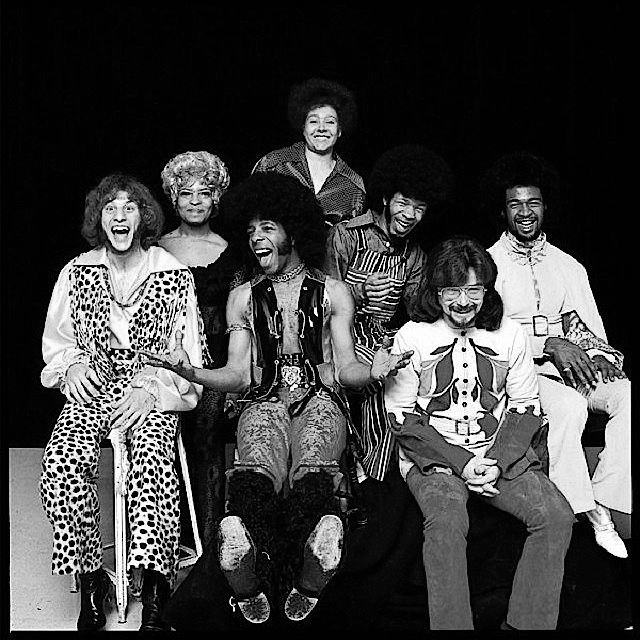Sly and the Family Stone weren’t just a band; they were a cultural phenomenon. Emerging from the vibrant San Francisco music scene of the late 1960s, they exploded onto the world stage with a sound that was as revolutionary as it was infectious. At the heart of their groundbreaking appeal was “Everyday People,” a song that transcended musical genres and social barriers, becoming an enduring anthem of unity and acceptance. More than just a catchy tune, “Everyday People Sly And The Family Stone” crafted a message that resonated deeply in a turbulent era, and continues to inspire generations today. This is the story of how Sly and the Family Stone, with “Everyday People” as their guiding light, broke down walls and built a legacy that continues to shape music and culture.
 Sly and the Family Stone
Sly and the Family Stone
The Genesis of a Groundbreaking Band
The vision for Sly and the Family Stone was born in the mind of Sylvester Stewart, later known as Sly Stone. A musical prodigy from a young age, Stone had already dipped his toes into various aspects of the music industry, from radio DJing to record production. But he harbored a deeper ambition: to create a band that mirrored the diverse tapestry of American society. In a time of stark racial division, Sly Stone envisioned a group that was not just musically integrated, but racially and gender-inclusive – a true “family” reflecting the “everyday people” he would later sing about.
He assembled a collective of incredibly talented musicians from diverse backgrounds. Alongside his brother Freddie Stone on guitar and sister Rose Stone on keyboards and vocals, the band included Larry Graham on bass, Jerry Martini on saxophone, Cynthia Robinson on trumpet, and Greg Errico on drums. This lineup itself was a statement. In an era where bands were often segregated along racial lines, Sly and the Family Stone boldly presented a united front of Black and white musicians, including women instrumentalists, challenging the status quo and embodying a message of interracial harmony.
Sly Stone’s musical ambitions were as broad as his social vision. He drew inspiration from a wide spectrum of artists, from the melodic innovation of The Beatles to the poetic depth of Bob Dylan, and the raw funk energy of James Brown and Otis Redding. He wanted to synthesize these diverse influences into a sound that was both commercially appealing and artistically groundbreaking, a sound that could bridge the gap between the predominantly white rock audience and the Black R&B fanbase.
Initially, the band honed their craft playing covers of popular hits, particularly soul and R&B tracks. These early performances were crucial in developing their signature stage presence, where each member was given space to shine, embodying Stone’s philosophy of shared spotlight and collective expression. They started introducing original compositions into their sets, revealing the early sparks of their unique sound. “I Ain’t Got Nobody (For Real)” stands as an example of their early evolution, showcasing how the individual contributions of each band member transformed Sly’s initial demo into something vibrant and distinctly their own.
“Dance to the Music” and Breakthrough
Despite their undeniable talent and captivating live shows, Sly and the Family Stone’s initial foray into recording was met with commercial indifference. Their debut album, “A Whole New Thing,” while appreciated by fellow musicians and critics for its innovation and musicianship, failed to resonate with the wider public. The record label, Epic Records, and particularly Clive Davis, recognized Sly Stone’s genius but urged him to create something more accessible, something that would translate their electrifying live energy into chart success.
This pressure for commercial viability led to the creation of “Dance to the Music.” While some band members, like Jerry Martini, initially viewed it as a compromise of their artistic vision, “Dance to the Music” proved to be the breakthrough they needed. Sly Stone, with his characteristic ingenuity, crafted a song that was both simple and irresistibly catchy. Its structure, rhythm, and call-and-response vocals were designed for dance floors, and its infectious energy was undeniable.
“Dance to the Music” incorporated elements from various sources, including the structure of their live shows, King Curtis’s “Memphis Soul Stew,” and even a serendipitous on-stage improvisation that became the song’s iconic “boom boom boom” vocal hook. Jerry Martini’s clarinet solo, born from a spur-of-the-moment decision, became another defining feature, adding an unexpected and distinctive flavor to the track.
 Sly and the Family Stone
Sly and the Family Stone
Released in 1968, “Dance to the Music” became a Top 10 hit, propelling Sly and the Family Stone into the national spotlight. It marked a turning point in their career, validating the label’s faith in their potential and opening doors to wider audiences. The song’s success was not just commercial; it also signaled the arrival of a fresh, dynamic sound that would influence countless artists in the years to come.
Building Momentum: “Life” and “Stand!” Albums
Following the breakthrough success of “Dance to the Music,” Sly and the Family Stone capitalized on their momentum with a series of albums and singles that solidified their position as musical innovators. The album “Dance to the Music,” while named after their hit, explored a more cohesive and dance-oriented sound. Tracks like “Ride the Rhythm” and the extended medley “Dance to the Medley” showcased their mastery of groove and their ability to keep audiences moving.
The album also featured “Higher,” an early iteration of what would become another signature song, “I Want to Take You Higher.” This constant evolution and revisiting of musical ideas demonstrated Sly Stone’s restless creativity and his commitment to pushing the boundaries of their sound.
Their third album, “Life,” marked a deliberate shift towards a more experimental and socially conscious direction. While still retaining their signature funkiness, “Life” incorporated elements of psychedelic rock and social commentary, reflecting the changing cultural landscape of the late 1960s. Songs like “Plastic Jim” and “Jane is a Groupee” showcased a more complex and sometimes darker lyrical perspective, aligning them with the burgeoning counterculture movement.
Despite its artistic merits, “Life” was not a commercial success initially. However, the band’s relentless touring and the continued popularity of “Dance to the Music” kept them in the public eye. A pivotal moment came with their appearance on “The Ed Sullivan Show.” Their performance, featuring a medley of “Dance to the Music,” “Music Lover,” and a preview of a new song, “Everyday People,” exposed them to a massive national audience, and set the stage for their next major breakthrough.
The album “Stand!” released in 1969, became a defining statement for Sly and the Family Stone. The title track, “Stand!”, with its powerful message of resilience and determination, resonated deeply with audiences. It became an anthem for a generation grappling with social and political upheaval. The album itself was a masterpiece of funk, soul, and rock fusion, showcasing the band at the peak of their creative powers.
“Stand!” was not just commercially successful, reaching gold status within months and staying on the charts for an impressive two years; it was also critically acclaimed. The album spawned another double-sided hit single. “Stand!” the A-side, reached number 22, while the B-side, “I Want to Take You Higher,” a re-energized and definitive version of their earlier song, became a Top 40 hit in its own right. “I Want to Take You Higher,” with its infectious energy and call-and-response vocals, became a live performance staple and another widely covered song, further cementing Sly and the Family Stone’s influence on the musical landscape.
“Everyday People”: The Anthem of Unity
It was the B-side previewed on Ed Sullivan, however, that would truly catapult Sly and the Family Stone into the stratosphere of cultural icons. “Everyday People” was a song of profound simplicity and universal appeal. Built around Larry Graham’s iconic single-note bassline and a basic “na-na-na-na-na” melody, the song’s genius lay in its accessibility and its powerful message of tolerance and understanding.
Sly Stone intentionally crafted “Everyday People” to be more than just a song; he envisioned it as a standard, a timeless piece that would resonate across generations, akin to “Jingle Bells” or “Moon River.” Its musical structure was deliberately simple, employing only two chords and a playground chant-like melody, making it instantly memorable and singable. Yet, within this simplicity lay a profound message.
The lyrics of “Everyday People” directly addressed the racial and social tensions of the time. In the final verse, the song tackled racial intolerance head-on, advocating for acceptance and understanding: “There is a yellow one that won’t accept the black one / That won’t accept the red one that won’t accept the white one.” In a nation grappling with the Civil Rights Movement and deep-seated racial divisions, this message of unity and equality was both timely and deeply impactful.
 Sly and the Family Stone
Sly and the Family Stone
“Everyday People” presented an optimistic vision of racial harmony, reflecting the hopes of the late 1960s, a time when many believed that legislative victories like the Voting Rights Act and Civil Rights Act had paved the way for a more equitable society. Sly Stone’s philosophy at the time, as expressed in his own words, emphasized individual responsibility and universal fairness: “Either everything’s fair or nothing’s fair. Either everybody gets a chance to do what he wants or… you know what I mean?”
The song’s message extended beyond race, encompassing broader themes of social harmony and acceptance of individual differences. The verse, “Different strokes for different folks / And so on and so on and scooby dooby dooby,” became a popular catchphrase, encapsulating the song’s core message of celebrating diversity.
Released in November 1968, “Everyday People” became an immediate sensation. It soared to number one on the Billboard Hot 100 chart, staying there for a month and selling over a million copies. Billboard ranked it as the fifth biggest hit of 1969. Sly Stone’s ambition for the song to become a standard was realized. “Everyday People” was covered by a vast array of artists across genres, from The Staple Singers and The Four Tops to Dolly Parton and Peggy Lee, each bringing their own interpretation to its timeless message.
Summer of ’69: Festivals and Cultural Peak
The summer of 1969 marked the zenith of Sly and the Family Stone’s cultural influence. They became festival headliners, performing at some of the most iconic events of the era, often sharing bills with a diverse range of artists reflecting the eclectic tastes of the time. From the Toronto Pop Festival to the Newport Jazz Festival, and the Harlem Cultural Festival, Sly and the Family Stone were at the forefront of the burgeoning festival scene.
Their performance at the Harlem Cultural Festival, later immortalized in the documentary “Summer of Soul,” was particularly significant. Playing in the heart of Harlem at a time of heightened racial tensions, Sly and the Family Stone brought their message of unity directly to the Black community, creating an atmosphere of celebration and solidarity.
The Newport Jazz Festival performance became infamous for a riot that erupted, often attributed to the band’s electrifying set. Whether they directly caused the riot or were simply the catalyst for pent-up energy, the event underscored the band’s powerful impact on audiences and the raw intensity of their live shows.
However, it was their performance at Woodstock that truly cemented their legendary status. Taking the stage in the early hours of the morning after a series of lackluster performances and facing a tired and sprawling crowd, Sly and the Family Stone initially struggled to connect. But with their characteristic energy and musicianship, they ignited the audience with an extended medley of their hits, including “Everyday People,” “Dance to the Music,” “Music Lover,” and “I Want to Take You Higher.”
 Sly and the Family Stone
Sly and the Family Stone
Their Woodstock performance was a tour de force, a testament to their ability to connect with massive audiences and deliver a message of joy and unity even in chaotic circumstances. Rolling Stone magazine hailed their performance as a highlight of the festival, declaring them the victors of a “Battle of the Bands” against other major acts. Woodstock marked the peak of Sly and the Family Stone’s ascent, a moment where their musical and cultural influence reached its zenith.
The Descent: Drugs, Internal Conflicts, and “Riot”
The heights of success reached by Sly and the Family Stone in the summer of 1969 were followed by a gradual and ultimately tragic decline. The seeds of their disintegration were sown amidst internal conflicts, drug abuse, and Sly Stone’s increasingly erratic behavior.
Cocaine, which had begun to gain popularity in counterculture circles, became a major factor in the band’s unraveling. Sly Stone, along with other members, became heavily reliant on the drug, which exacerbated existing tensions and fueled paranoia and instability within the group.
Interpersonal relationships within the band became strained. Romantic entanglements, business disputes, and the influence of Sly’s increasingly volatile entourage contributed to a toxic atmosphere. David Kapralik, their manager, found himself increasingly unable to control Sly, eventually succumbing to the same drug use that was consuming his client.
As Sly Stone’s drug use escalated, his behavior became increasingly unpredictable. He and his brother Freddie began showing up late for gigs, or not at all, damaging their reputation and alienating their bandmates and audiences. The band’s performances became inconsistent, and the sense of unity and shared purpose that had once defined them began to erode.
Amidst this turmoil, Sly Stone continued to create music, but his creative process became increasingly isolated and fragmented. He began to rely more on studio overdubs and session musicians, distancing himself from the core band members. The album “There’s a Riot Goin’ On,” released in 1971, reflected this shift. While critically acclaimed for its groundbreaking sound and introspective lyrics, “There’s a Riot Goin’ On” was a departure from the upbeat, unifying spirit of their earlier work. Its dark, murky sound and themes of social disillusionment and personal breakdown mirrored Sly Stone’s own descent into addiction and isolation.
Despite its somber tone, “There’s a Riot Goin’ On” was a commercial success, reaching number one on the album charts and spawning the number-one single “Family Affair.” However, “Family Affair” would be their last chart-topping single, and “There’s a Riot Goin’ On” marked a turning point, signaling the beginning of the end for the original Sly and the Family Stone.
The Breakup and Aftermath
The years following “There’s a Riot Goin’ On” saw the gradual disintegration of Sly and the Family Stone. Key members began to depart, starting with drummer Greg Errico, who left during the “Riot” sessions, citing the increasingly “ugly” atmosphere within the band. Larry Graham, whose signature basslines had been so integral to their sound, also left to form his own successful group, Graham Central Station.
Subsequent albums, “Fresh” (1973) and “Small Talk” (1974), were shadows of their former glory. While “Fresh” contained the hit single “If You Want Me To Stay,” the overall quality of their output declined, reflecting the band’s internal fragmentation and Sly Stone’s diminishing creative focus. “Small Talk” is widely considered to be the first truly weak album of their career, signaling the imminent demise of the original lineup.
By 1975, Sly and the Family Stone had effectively ceased to exist as a cohesive unit. Sly Stone embarked on a solo career, releasing albums under his own name and ersatz “Sly and the Family Stone” monikers, but none of these projects captured the magic of the original band.
The legacy of Sly and the Family Stone, however, remained profound. Their innovative fusion of funk, soul, and rock, their message of interracial unity, and their electrifying stage presence had irrevocably changed the landscape of popular music. They paved the way for countless artists, from Prince and Michael Jackson to Stevie Wonder and the Red Hot Chili Peppers, who drew inspiration from their groundbreaking sound and fearless approach to music-making.
Even after their breakup, the individual members of Sly and the Family Stone continued to contribute to music in various ways. Rose Stone became a successful backing vocalist, Freddie Stone became a pastor, and Jerry Martini and Cynthia Robinson continued to perform and keep the spirit of the band alive.
In 2006, a partial reunion of the original lineup, minus Larry Graham, at the Grammy Awards offered a brief glimpse of their former glory, though it was marred by Sly Stone’s erratic behavior. Despite the challenges and tragedies that marked their later years, the enduring power of Sly and the Family Stone’s music, and particularly the timeless message of “Everyday People,” continues to resonate.
Conclusion
“Everyday People” remains more than just a song; it is a cultural touchstone, an anthem of unity and acceptance that transcends generations. Sly and the Family Stone, with “Everyday People” as their signature statement, left an indelible mark on music history. They dared to break down racial and social barriers, creating a sound that was both groundbreaking and universally appealing. While their journey was ultimately marred by personal struggles and internal conflicts, their musical legacy, and the enduring message of “everyday people sly and the family stone,” continues to inspire and uplift, reminding us of the power of music to unite and heal.


